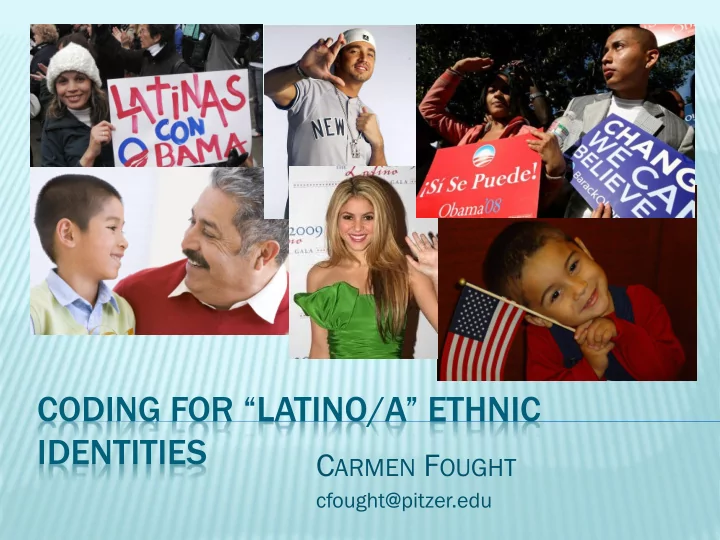

CODING FOR “LATINO/A” ETHNIC IDENTITIES C ARMEN F OUGHT cfought@pitzer.edu
I. NEW DEMOGRAPHIC DATA ON LATINOS/AS IN THE U.S. In 2003, the U.S. Census shows that La Latin inos os an and La Latinas nas had re repla laced ced Afri rican can Ame meric ricans ans as the e la larg rgest est mi mino nority rity et ethnic nic group up in the U.S. Since the turn of the century, Hispanics have accounted for mo more re than n half lf (5 (50.5 .5%) ) of the e overall erall popu pula lati tion on growth wth in the United States As of mid-2007, Hispanics made up 15.1% 1% of the e total l U.S. S. popu opula lation ion
Latino population growth in the new century = more a product of the natural in increa ease e of the e exis istin ing g po popu pulati tion on than of new international migration. Also, tends to take place in what the Census calls “metropolitan counties”, mid to large cities. Through the 1990’s, and still continuing = growth of Latin ino po popu pulati tions ons in in new area eas, e. e.g. g. the e South. th. [Example: Between 1990 and 2000, North Carolina experienced a higher percentage of growth in its Mexican-American population than any other state (Wolfram, Carter and Moriello 2004). ]
QUESTION: How are these factors likely to affect linguistic patterns? QUESTION: What are some of the ways these trends might shape ethnic identity?
II II. . FACT CTORS ORS TO CONSIDER NSIDER IN IN CODING DING ET ETHNIC NIC ID IDEN ENTIT TITY Y AMONG NG LA LATINAS/ INAS/OS OS: GE GENE NERA RATIO TION : second generation vs. first generation first generation long-term residents vs. recent immigrants recent immigration from one state to another
NATIONAL TIONAL OR ORIGIN: GIN: country of ancestry dominant ancestry of local population possibility of mixed ancestry from 2 or more Spanish-speaking countries
RACE CE: ( meaning “racial projects” – as in Omi and Winant 1994) racial group of origin as identified in community ideologies possibility of “unmixed” racial overlap, as described in example possibility of “mixed” racial identification (e.g. one white parent, one Latino parent)
II III. I. POSSIBLE OSSIBLE MET ETHODS HODS FOR R COLLE LLECTING CTING THES ESE E FOR R ARCHIVING: RCHIVING: Sel elf-id iden entif ifica icati tion on da data (non-structured) tructured) coll llect ected ed in in in inter ervie iews ws: : (Fought 2003) When people ask me [about ethnicity] I say Mexican but, but then they say, „No you‟re not. You don‟t speak Spanish.‟ It‟s funny, though. Like I‟m all into this Chicano activist shit and.... They ask me “Are you black?” I‟m like, “No, I‟m Hispanic.” (from Bailey 2000)
Que uesti tions ons focusing ocusing on th n the e mea eani ning ngs of spe pecif ific ic iden id entit ity ter erms: s: I: What about “Hispanic”? S: That sounds better. More professional, you know. Like „the Hispanic flu‟. Or naturall lly y occ ccurr urrin ing g comme omments: ts: A lot of Hispanics, like, Mexican families, they‟re really strict, especially with the girls.
Documentation of “tensions” and boundaries in the e communi mmunity ty id ideo eology: gy: The vanamachos … that‟s what everybody calls them and shit. You know the border brothers or whatever, and then... like, my homeboys be jacking them or whatever you know. If you‟re walking down the street and there‟s a group of just- straight- just- you know, schoolboy- just- nobodies, and there‟s a group of gangbangers, they might, you know, harass them because they know they can get away with it.
QUESTION: How can the particular term a speaker uses to self-identify give us insight into their ethnic identity (if at all)?
IV. LATINO INO LANG NGUAGE GE VARIETIES IETIES A A "S "Sta tanda ndard" d" En English lish A Lat atino no En English lish var ariety ty (e.g. Chicano English) Ot Other er lo local cal var arieties ties of En English lish (e.g. Appalachian English, African-American English) No Non-nat nativ ive e Speak aker En English lish (influenced by Spanish) Code ode-switc switching hing (Just counting varieties of English…..)
QUESTION: What can the development of incipient Latino Englishes, e.g. the ones being studied in North Carolina, tell us about the construction of ethnic identity? QUESTION: Is it possible we could work backwards and allow the speaker’s use of particular linguistic codes to help us define their ethnic identity?
SPANISH VOICES: SPANISH AND ENGLISH IN THE SOUTHEASTERN UNITED STATES North Caroling Language and Life Project (NCLLP) Produced by Danica Cullinen and Walt Wolfram
Ref efer erenc ences: es: Bailey, Benjamin. (2000). Language and negotiation of ethnic/racial identity among Dominican Americans. Language in Society 29:555-582 Fought, Carmen. 2003. Chicano English in Cont ext. New York: Palgrave/Macmillan Press. Fought, Carmen. 2006. Language and Ethnicity . New York: Cambridge University Press. Omi, M. and H. Winant. 1994. Racial Formation in the United States: From the 1960s to the 1990s. New York & London: Routledge. Pew Hispanic Center: 2008. Latinos Account for Half of U.S. Population Growth Since 2000. http://pewresearch.org/pubs/1002/latino- population-growth Pew Hispanic Center. 2009. Hispanics of Mexican Origin in the United States, 2007. pewhispanic.org/files/factsheets/49.pdf Wolfram, Walt, Phillip Carter & Beckie Moriello. 2004. Emerging Hispanic English: New dialect formation in the American South. Journal of Sociolinguistics 8:339-358.
Recommend
More recommend